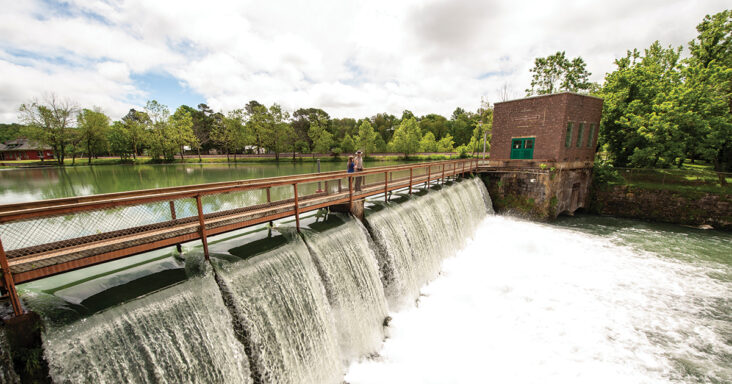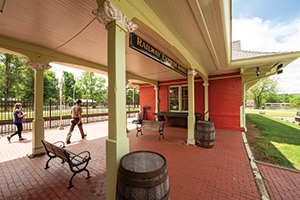Mammoth Spring history includes Native American lore, infamous criminals
by May 7, 2023 9:15 am 1,905 views

His editor sent him on an assignment to cover the funeral of a World War I soldier in Mammoth Spring, an Ozark Mountain hamlet that sits on the border between Arkansas and Missouri.
When he arrived, he marveled at the Mammoth Spring, the largest spring in Arkansas and reportedly the second largest in the Ozark Mountain region. That night he was invited to a “hoedown” at a local cabin where musicians played guitars, banjos, fiddles and other instruments until dawn.
“No one in the world has ever had more fun than those Ozark mountaineers did that night,” Hay said years later. “It stuck with me until the idea became ‘The Grand Ole Opry.’”
It’s been more than a century since Hay visited the town located in Fulton County, but each year more than 350,000 people visit Mammoth Spring State Park, according to state records. The spring has been declared a National Landmark, one of the few in Arkansas, former Park Superintendent Dave Jackson told Talk Business & Politics.
“There’s something special about the first time you go and see the spring. You are in awe,” he said. “It pulls you in. There’s nothing like it.”

The park and surrounding area have a deep and rich history that stretches back to paleolithic times, Jackson said. Arrow heads, pottery, and other artifacts indicate that Native Americans were in the vicinity of the spring thousands of years ago. The Osage were known to use the area as a hunting ground. According to Osage lore, the tribe was suffering through a drought and the chief’s son died. Due to his grief, he ordered all the tribe’s warriors to be executed. The tribe had to dig a mass grave and when they did water from the spring began percolating to the surface, according to the legend.
Settlers of European ancestry entered the region in 1820, according to the Encyclopedia of Arkansas. In 1836, the state was born and when its borders were established the spring ended up in Arkansas by only 497 feet.
For the next 100 years, the spring was part of an industrial complex that was built in the town. Mills were built. Skirmishes were fought between Union and Confederate soldiers in and around the town in 1863.
The Reunion of the Blue and Gray, or the “Old Soldiers Reunion,” became an annual event on the grounds of what is now the state park in 1893. Former soldiers from both sides of the conflict would congregate for a week in August. An old Civil War cannon would be fired each night of the Reunion and the soldiers would exchange war stories and sing songs in front of a roaring fire. The event evolved in later years to include veterans of all wars.
In the early 1880s, the Frisco Railroad laid lines through the town and a depot was built in what is now the park.

The federal government built a fish hatchery at the park. In the 1920s, the dam was converted for hydroelectric production. Jackson said the city experienced a boom from the 1880s until about 1930, and at its height the city had about 1,500 residents. That changed when the Great Depression hit and the industrial base that fueled the local economy evaporated.
During this time, one of the most notorious criminals of the 20th Century, Ma Barker, lived just a few miles from town. The Tommy-gun wielding Barker was the matriarch of the Barker clan, a family that committed numerous crimes all over the United States including the murder of a sheriff in the nearby town of West Plains, Mo.
Acclaimed actress Tess Harper grew up in Mammoth Spring and graduated from high school there in 1968. She was nominated for an Academy Award for her role in the movie “Crimes of the Heart” and had a recurring role on the hit show “Breaking Bad” among her many performances.
Mammoth Spring and adjacent land remained in the hands of various owners following the Great Depression. In 1957, the Arkansas Legislature designated Mammoth Spring as a state park, but parts of it were owned by various landowners and an agreement couldn’t be reached until 1975 when construction on a visitor center started.
The dam no longer generates electricity, and has been turned into a museum. The train depot, the oldest still in its original location in Arkansas, is there along with the Federal fish hatchery.
